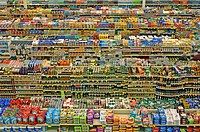
Photo from wikipedia
Postbiotics are non-viable bacterial products or metabolic byproducts produced by probiotic microorganisms that have biologic activity in the host. Postbiotics are functional bioactive compounds, generated in a matrix during anaerobic… Click to show full abstract
Postbiotics are non-viable bacterial products or metabolic byproducts produced by probiotic microorganisms that have biologic activity in the host. Postbiotics are functional bioactive compounds, generated in a matrix during anaerobic fermentation of organic nutrients like prebiotics, for the generation of energy in the form of adenosine triphosphate. The byproducts of this metabolic sequence are called postbiotics, these are low molecular weight soluble compounds either secreted by live microflora or released after microbial cell lysis. A few examples of widely studied postbiotics are short-chain fatty acids, microbial cell fragments, extracellular polysaccharides, cell lysates, teichoic acid, vitamins, etc. Presently, prebiotics and probiotics are the products on the market; however, postbiotics are also gaining a great deal of attention. The numerous health advantages of postbiotic components may soon lead to an increase in consumer demand for postbiotic supplements. The most recent research aspects of postbiotics in the food and pharmaceutical industries are included in this review. The review encompasses a brief introduction, classification, production technologies, characterization, biological activities, and potential applications of postbiotics.
Journal Title: Foods
Year Published: 2022
Link to full text (if available)
Share on Social Media: Sign Up to like & get
recommendations!